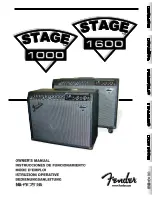
20
User’s Guide DMC-842
© RME
10.4 Auto ID (Au)
Default: Off
Available settings: On, Off
This option relates to the use of the I64 MADI Card. Multiple DMC-842 (and ADI-
642/Micstasy/ADI-8 QS, see chapter 14.3/14.4) connected serially can assign consecutive IDs
to themselves. For this to happen, Auto ID is set to
On
at the first device of the chain. All other
devices automatically turn into slaves. An Auto ID slave has the middle dot lit in the GAIN dis-
play of channel 8.
10.5 Delay Compensation (dC)
Default: 0ff
Available settings: On, Off
This option relates to the use of the I64 MADI Card. When multiple devices are connected seri-
ally, the MADI I/O of each DMC-842 causes a delay of 3 samples. Therefore at the MADI output
of the last device, the data of all upstreamed devices are delayed. At Double Speed the delay
rises to 6 samples per unit, at Quad Speed to 12 samples.
The problem of this offset is solved by the function
Delay Compensation.
It delays the signals in
a way that they are sample-synchronous in multi-device operation.
Delay Compensation has to be manually activated in each unit!
The following table lists the delay in samples from two up to eight units connected serially.
When using four units, the data of the first unit are delayed by 9 samples to the last unit, the
units 2 and 3 are delayed by 6 and 3 samples respectively. At Double Speed and Quad Speed
the values rise. Please note that in Double Speed no more than four, in Quad Speed no more
than two DMC-842 can be used serially with MADI.
Units
Delay
Delay DS
Delay QS
DC
DC DS DC QS
2
3 6 12
21
18
12
3 6
12 -
21
18
-
4 9
18 -
21
18
-
5
12
- - 21
-
-
6
15
- - 21
-
-
7
18
- - 21
-
-
8
21
- - 21
-
-
As shown in the table, activating DC causes a constant delay of 21 samples in Single Speed,
no matter how many devices are connected serially. In Double Speed the delay is 18, in Quad
Speed 12 samples. The in most cases slightly increased delay is outweighed by the big advan-
tage of sample-aligned I/Os when using multiple units.
Delay Compensation always uses the worst case, the operation of 8 units, but delays the sig-
nals individually. The amount of the respective delay is solely derived from the current ID, no
matter if it has been assigned manually or by Auto ID.
21 samples @ 48 kHz
equal 437 µs.
18 samples @ 96 kHz
equal 187 µs.
12 samples @ 192
kHz equal 62.5 µs.
Summary of Contents for DMC-842
Page 5: ...User s Guide DMC 842 RME 5 User s Guide DMC 842 General...
Page 12: ...12 User s Guide DMC 842 RME...
Page 13: ...User s Guide DMC 842 RME 13 User s Guide DMC 842 Usage and Operation...
Page 29: ...User s Guide DMC 842 RME 29 User s Guide DMC 842 Inputs and Outputs...
Page 39: ...User s Guide DMC 842 RME 39 User s Guide DMC 842 Technical Reference...
















































